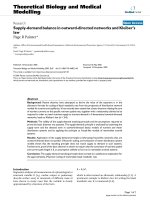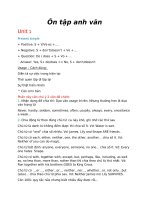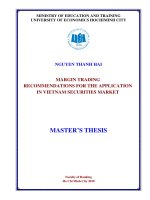Trend trading with supply demand imbalance in any financial market
Bạn đang xem bản rút gọn của tài liệu. Xem và tải ngay bản đầy đủ của tài liệu tại đây (13.2 MB, 180 trang )
By Bennybl
www.bennybl.com
1
1.
2.
3.
4.
5.
6.
7.
8.
9.
10.
11.
12.
13.
14.
15.
16.
17.
18.
What is supply & demand
Only Four Trading Patterns to identify
How to identify and Draw supply demand
Two Elements to consider in Any Trade – Location & Structure
3 types of trade setup
What is Trend? How to define a Trend? How to draw trendline consistently? How do we
know trend ending?
How & when to trade Counter Trend (CT)
How to know market top /bottom
Supply/Demand in Control
Types of Trade Entry & When & How to use them
How to trade head & shoulder our way
How & When to trade Continue Pattern CP
What a Good Base should like
How to Validate Supply demand
Structure of trade
How to trade with Multiple Time Frames
Momentum breakout (MBO)
Secret In Trading
When supply exceeds demand, there is going to be a turn
in price. Price is driven down due to the quantity of goods
produced & lack of demand for those goods being
produced.
Price move down due to more sell orders than buy orders
(imbalance between sellers & buyers). The price ranging
before it drop, we call this zone as supply.
We look to sell in the future when price retrace back to this
supply(SZ)
Reason: When there are strong imbalance, it also mean
there are “unfilled” sell orders at the supply.
When demand exceeds supply, there is going to be a turn
in price. Price is driven up due to the quantity of goods
demand & lack of supply for those goods being demanded.
Price move higher due to more buyers than sellers
(imbalance)
The price raging before the rise, we call the zone
“demand”. We look to buy in the future if price retrace back
to the demand
Reason: Because of strong imbalance, there are unfilled buy
orders at the demand waiting to be filled
Drop-base-rally
(RP)
Rally-base-rally
(CP)
Rally-base-drop
(RP)
Drop-base-drop
(CP)
When there is only one candle that form the base. That
single candle is the base
When there are more than one candle form the base, any
candlestick that has a body less than 50% of its range is
part of the base
When the candle’s body is less than 10%, L1 and L2 are
drawn on the top & bottom of the candle, otherwise, the L1
is drawn on the open/closed of the candle & L2 draw on the
end of the candle
Candle body
<10%
Single candle
>10% body
Doji + candle
Candle <50% body
In order to draw supply demand in a consistent way, we need to
know the made up of supply & demand
◦ Supply demand always make up of two legs, first leg in and 2nd leg out.
◦ 2nd leg is the key, we look for strong departure. extended range candle (erc),
closing near its candle high
◦ Maximum 6 candles in the base. No matter which timeframe
◦ When there are more than one candle, Tight candle bases with bodies <= 50% of
the candle range are consider part of the base
DO NOT CONSIDER A BASE THAT:
Has only doji candles as a base
Has more than 6 candles
The candle closing price is stairsteps formation
Wicky candles
So many demands to choose
which demands to long
To look for demand, we start from current price and look down and left until arrive a long
candle (ERC), then look to the base of the ERC, that is the demand.
L1
L1
L2
L1to place limit entry
L2 to place stop loss
Location
Buy Low Sell High
Structure
of Trade
Departure
Time
Profit
Fresh
Arrival
For higher odds we want to buy low in the location and sell
high in the location.
Questions: HOW HIGH IS HIGH IN THE LOCATION? HOW LOW
IS LOW?
When Price is above 90%. Long is no longer allow. When
price is below 10%, Short is not allow. On the other hand,
when price is very low & near the demand, it’s the best
location to long. This is the location trade.
We pay attention to the location in monthly, weekly and
daily.
HTF supply
90%
HTF demand
HTF supply
10%
HTF demand
When location is too low, sell not allow. Wait for price
retrace higher to a supply & sell again
HTF (Monthly) Supply
Option 1
supply
Price is too low on location.
Sell is not allow now. Wait for
price to pullback higher to supply
HTF Monthly Demand
we need to wait for HTF Demand removed, before we
continue look for selling opportunity
HTF Supply
Option 2
Price too low in location, wait
for price to remove demand
HTF Demand
Brand new supply
created
Location too high, wait for supply removed and
continue look for demand to long
1. Trend
trading = High odds
2. Location (counter-trend) = low odds
3. Trend + location = highest odds
Trend is series of price swings traveling in the same direction over
time.
By objectively assessing the trend, trader will then able to prepare
to take the next step.
Trader need to assess the strength of up trend in order to find
buying opportunity.
In up trend, traders look to put on new position or add on new
position on pullback to expected demand.
Once a trend established, it has greater odds of continuing than
reversing. If we accept this as true, then most profitable , lowest
risk opportunity will come trading on pullback in the direction of a
trend.
Trend can’t persist forever. A downtrend evolve into up trend, &
matured up trend evolve into down trend.









